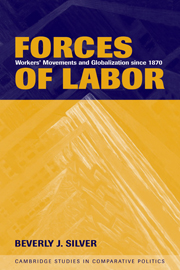Book contents
- Frontmatter
- Contents
- List of Figures
- List of Tables
- Preface and Acknowledgments
- 1 INTRODUCTION
- 2 LABOR MOVEMENTS AND CAPITAL MOBILITY
- 3 LABOR MOVEMENTS AND PRODUCT CYCLES
- 4 LABOR MOVEMENTS AND WORLD POLITICS
- 5 CONTEMPORARY DYNAMICS IN WORLD-HISTORICAL PERSPECTIVE
- Appendix A The World Labor Group Database: Conceptualization, Measurement, and Data Collection Procedures
- Appendix B Instructions for Recording Data from Indexes
- Appendix C Country Classifications
- References
- Index
- Cambridge Studies in Comparative Politics
Preface and Acknowledgments
Published online by Cambridge University Press: 05 June 2012
- Frontmatter
- Contents
- List of Figures
- List of Tables
- Preface and Acknowledgments
- 1 INTRODUCTION
- 2 LABOR MOVEMENTS AND CAPITAL MOBILITY
- 3 LABOR MOVEMENTS AND PRODUCT CYCLES
- 4 LABOR MOVEMENTS AND WORLD POLITICS
- 5 CONTEMPORARY DYNAMICS IN WORLD-HISTORICAL PERSPECTIVE
- Appendix A The World Labor Group Database: Conceptualization, Measurement, and Data Collection Procedures
- Appendix B Instructions for Recording Data from Indexes
- Appendix C Country Classifications
- References
- Index
- Cambridge Studies in Comparative Politics
Summary
The origins of this book can be traced back to a conference paper presented almost twenty years ago with Giovanni Arrighi at the Seventh Political Economy of the World-System conference organized by Charles Bergquist at Duke University. The paper, entitled “Labor Movements and Capital Mobility: the United States and Western Europe in World-Historical Perspective,” was a first attempt at understanding how outcomes for different national labor movements are linked to each other by world-economic processes, especially the transnational relocation of capital. Over the years, this first seed grew, fused with other seeds, and developed into the present book. Ongoing exchanges with Giovanni Arrighi over this entire time period have left an indelible mark on the final product, and I therefore start by acknowledging my intellectual debt to him.
Another debt is owed to the members of the World Labor Research Group – a group of faculty and graduate students who met regularly at the Fernand Braudel Center at Binghamton University in the 1980s. Apart from myself, the members of the research group were Giovanni Arrighi, Mark Beittel, John Casparis, Jamie Faricellia Dangler, Melvyn Dubofsky, Roberto Patricio Korzeniewicz, Donald Quataert, and Mark Selden. It was in the course of discussions within this group that it became clear that the serious study of labor movements from a global and historical perspective would require new types of data that were simply not available in existing compilations. In 1986 the group plunged into a massive data collection project, initiating the World Labor Group (WLG) database, on which this book stands.
It soon became clear that the creation of this database would require an enormous effort and that it risked never being completed.
- Type
- Chapter
- Information
- Forces of LaborWorkers' Movements and Globalization Since 1870, pp. xiii - xviPublisher: Cambridge University PressPrint publication year: 2003

